1998 CHEVROLET VENTURE oil filter
[x] Cancel search: oil filterPage 336 of 474

Section 6 Service and Appearance Care
Here you will find information about the care of your vehicle. This section begins with service and fuel information,
and then it shows how to check important fluid and lubricant levels. There is also technical information about your
vehicle, and
a part devoted to its appearance care.
6- 18
6-2 1
6-24
6-25
6-26
6-30
6-3
1
6-39 6-2
Service
6-3 Fuel
6-7 Filling a Portable Fuel Container
6-
8 Checking Things Under the Hood
6-11 Engine Oil
6-15 Air Cleaner
6-16 Passenger Compartment Air Filter
Replacement
Automatic Transaxle Fluid
Engine Coolant
Radiator Pressure Cap
Windshield Washer Fluid
Brakes
Battery
Bulb Replacement
Windshield Wiper Blade Replacement 6-40
6-48
6-48
6-52
6-54
6-54
6-55
6-56
6-57
6-64
6-65
6-65
6-66
6-66
6-66 Tires
Appearance
Care
Cleaning the Inside of Your Vehicle
Cleaning the Outside of Your Vehicle
Underbody Maintenance Chemical Paint Spotting
Appearance Care Materials Chart
Vehicle Identification Number (VIN)
Electrical System
Replacement Bulbs
Capacities and Specifications
Engine Specifications
Vehicle Dimensions
Normal Maintenance Replacement Parts
Air Conditioning Refrigerants
ProCarManuals.com
Page 349 of 474
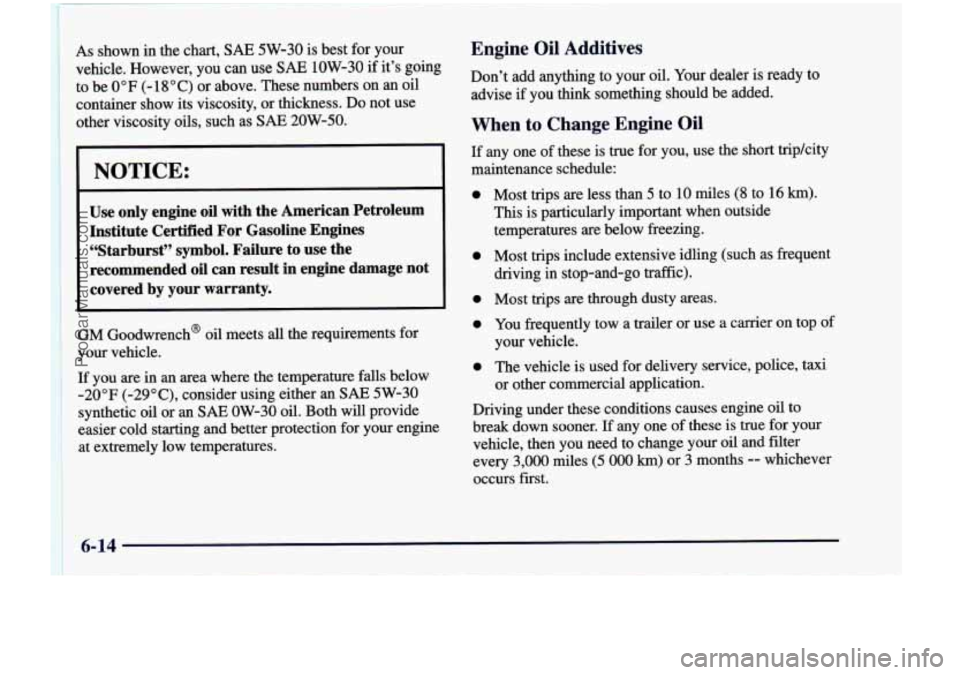
As shown in the chart, SAE 5W-30 is best for your
vehicle. However, you can use
SAE 1OW-30 if it's going
to be
0" F (- 18 " C) or above. These numbers on an oil
container show its viscosity, or thickness. Do not use
other viscosity oils, such as
SAE 20W-50.
NOTICE:
Use only engine oil with the American Petroleum
Institute Certified For Gasoline Engines
"Starburst" symbol. Failure to use the
recommended oil can result in engine damage not
covered by your warranty.
GM Goodwrench@ oil meets all the requirements for
your vehicle.
If you are in an area where the temperature falls below
-20°F (-29"C), consider using either an
SAE 5W-30
synthetic oil or an
SAE OW-30 oil. Both will provide
easier cold starting and better protection for your engine
at extremely low temperatures.
Engine Oil Additives
Don't add anything to your oil. Your dealer is ready to
advise
if you think something should be added.
When to Change Engine Oil
If any one of these is true for you, use the short tripkity
maintenance schedule:
0
0
0
0
0
Most trips are less than 5 to 10 miles (8 to 16 km).
This is particularly important when outside
temperatures are below freezing.
Most trips include extensive idling (such as frequent
driving in stop-and-go traffic).
Most trips are through dusty areas.
You frequently tow
a trailer or use a carrier on top of
your vehicle.
The vehicle is used for delivery service, police, taxi
or other commercial application.
Driving under these conditions causes engine oil to
break down sooner.
If any one of these is true for your
vehicle, then you need to change your oil and filter every
3,000 miles (5 000 km) or 3 months -- whichever
occurs fust
.
6-14
ProCarManuals.com
Page 350 of 474
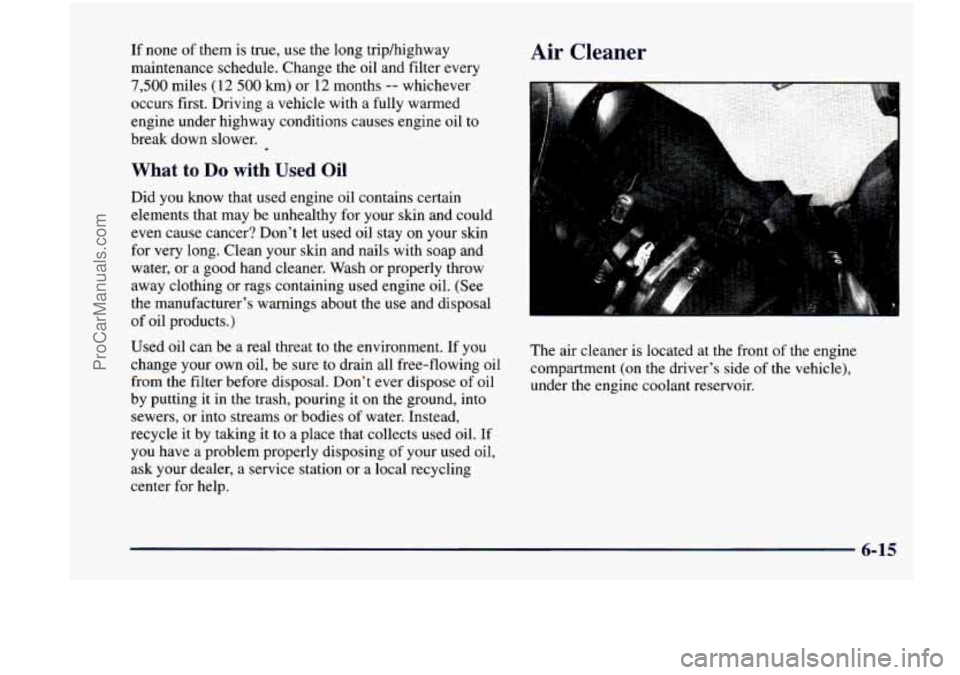
If none of them is true, use the long triphighway
maintenance schedule. Change the oil and filter every
7,500 miles (12 500 km) or 12 months -- whichever
occurs first. Driving a vehicle with a fully warmed
engine under highway conditions causes engine oil to
break down slower.
.
What to Do with Used Oil
Did you know that used engine oil contains certain
elements that may be unhealthy for your skin and could
even cause cancer? Don’t let used oil stay on your skin
for very long. Clean your skin and nails with soap and
water, or a good hand cleaner. Wash or properly throw
away clothing or rags containing used engine oil. (See
the manufacturer’s warnings about the use and disposal
of oil products.)
Air Cleaner
Used oil can be a real threat to the environment. If you The air cleaner is located at the front of the engine
change your own oil, be sure
to drain all free-flowing Oil compartment (on the driver’s side of the vehicle),
from the filter before disposal. Don’t ever dispose of oil under the engine coolant reservoir.
by putting it in the trash, pouring it on the ground, into
sewers, or into streams or bodies of water. Instead,
recycle it by taking it to a place that collects used oil. If
you have a problem properly disposing of your used oil,
ask your dealer, a service station or a local recycling
center for help.
6-15
ProCarManuals.com
Page 353 of 474
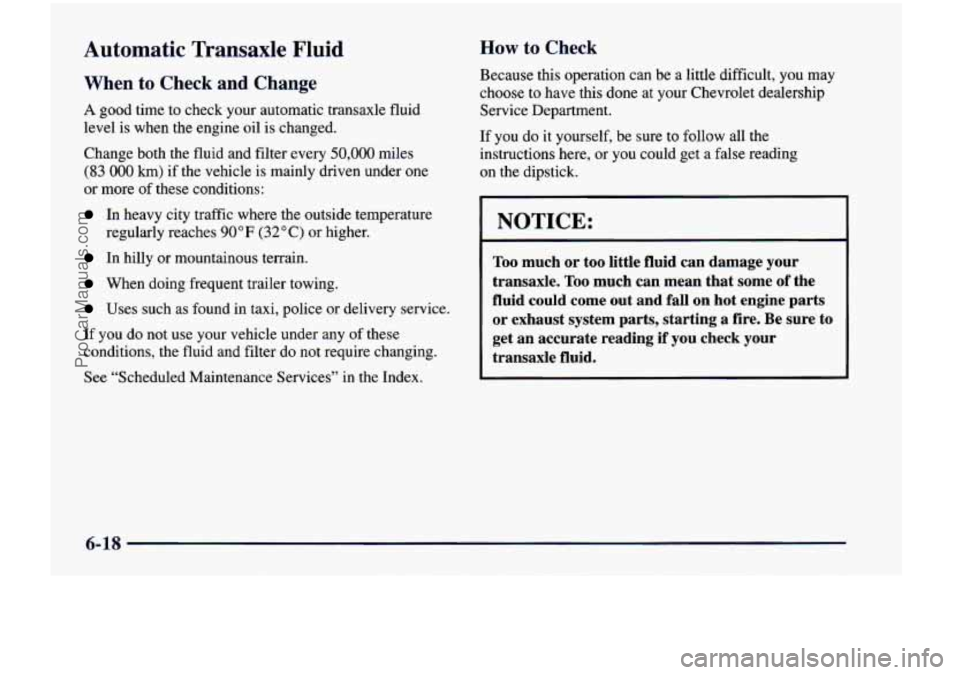
Automatic Transaxle Fluid
When to Check and Change
A good time to check your automatic transaxle fluid
level is when the engine oil is changed.
Change both the fluid and filter every
50,000 miles
(83 000 km) if the vehicle is mainly driven under one
or more of these conditions:
In heavy city traffic where the outside temperature
In hilly or mountainous terrain.
When doing frequent trailer towing.
Uses such as found in taxi, police or delivery service.
regularly reaches
90°F (32 O C) or higher.
If you do
not use your vehicle under any of these
conditions, the fluid and filter do not require changing.
See “Scheduled Maintenance Services’’ in the Index.
How to Check
Because this operation can be a little difficult, you may
choose to have this done at
your Chevrolet dealership
Service Department.
If you do it yourself, be sure to follow all the
instructions here, or you could get a false reading
on the dipstick.
NOTICE:
Too much or too little fluid can damage your
transaxle.
Too much can mean that some of the
fluid could come out and fall on hot engine parts
or exhaust system parts, starting a fire. Be sure to
get an accurate reading if you check your
transaxle fluid.
6-18
ProCarManuals.com
Page 400 of 474
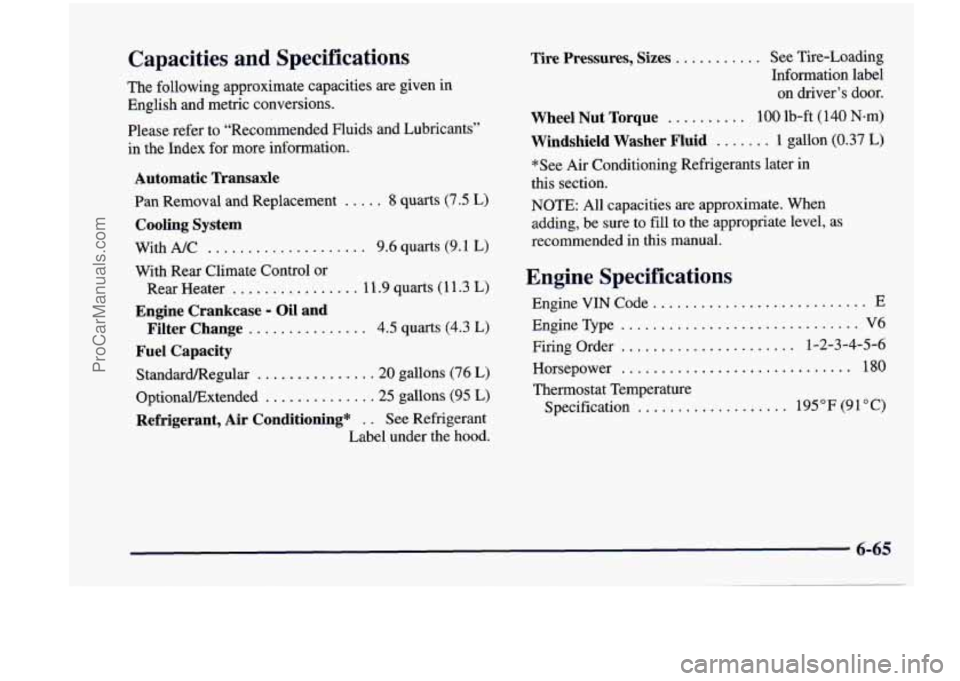
Capacities and Specifications
The following approximate capacities are given in
English and metric conversions.
Please refer to “Recommended Fluids and Lubricants”
in the Index for more information.
Automatic Transaxle
Pan Removal and Replacement ..... 8 quarts (7.5 L)
Cooling System
With A/C .................... 9.6 quarts (9.1 L)
With Rear Climate Control or
Engine Crankcase - Oil and
Fuel Capacity
Rear Heater ................ 11.9 quarts (11.3 L)
Filter Change ............... 4.5 quarts (4.3 L)
StandardRegular .............. .20 gallons (76 L)
OptionaVExtended ............. .25 gallons (95 L)
Refrigerant, Air Conditioning* . . See Refrigerant
Label under the hood.
Tire Pressures, Sizes ........... See Tire-Loading
Information label
on driver’s door.
Wheel Nut Torque .......... 100 lb-ft (140 N-m)
Windshield Washer Fluid ....... 1 gallon (0.37 L)
*See Air Conditioning Refrigerants later in
this section.
NOTE: All capacities are approximate. When
adding,
be sure to fill to the appropriate level, as
recommended in
this manual.
Engine Specifications
Engine VIN Code ........................... E
Firing Order ...................... 1-2-3-4-5-6
EngineType
.............................. V6
Horsepower ............................. 180
Thermostat
Temperature
Specification
................... 195 “F (91 “C)
6-65
ProCarManuals.com
Page 401 of 474

I.’ *
Vehicle Dimensions - Regular
Wheel Base
Length ................. 186.9 inches (474.6 cm)
Width
...................... 72 inches (1 83 cm)
Height
................... 67.4 inches (1 7 1.2 cm)
Wheelbase
................ 112 inches (284.5 cm)
Front Tread Width
......... 6 1.5 inches (1 56.2 cm)
Rear Tread Width
.......... 63.3 inches ( 160.8 cm)
Vehicle Dimensions - Extended
Wheel Base
Length ................. 200.9 inches (510.2 cm)
Width
...................... 72 inches (183 cm)
Height
................... 68.1 inches (1 72.9 cm)
Wheelbase
................ 120 inches (304.7 cm)
Front Tread Width
......... 61.5 inches (156.2 cm)
Rear Tread Width
.......... 63.3 inches (160.8 cm)
Normal Maintenance Replacement Parts
Air Cleaner Filter ............. AC Type A- 1208C
Engine Oil Filter
........................ PF47
Spark Plugs
................... AC Type 41-940
Passenger Compartment Air Filter (2)
.... 52470574
Gap:
0.060 inches (1.5 mm)
Windshield Wiper Blades Length
..................... 24 inches (60 cm)
Type
......................... Shepard’s Hook
Length .................... 16 inches (40.6 cm)
Type
......................... Shepard’s Hook
Backglass Wiper Blade
Air Conditioning Refrigerants
Not all air conditioning refrigerants are the same.
If the
air conditioning system in your vehicle needs
refrigerant, be sure the proper refrigerant
is used. If
you’re not sure, ask your dealer.
ProCarManuals.com
Page 408 of 474

Maintenance Schedule
I Short Trip/City Definition 1
Follow the Short TripKity Maintenance Schedule if any
one
of these conditions is true for your vehicle:
Most trips are less than 5 to 10 miles (8 to 16 krn).
This is particularly important when outside
temperatures are below freezing.
0 Most trips include extensive idling (such as frequent
driving in stop-and-go traffic).
Most trips are through dusty areas.
0 You frequently tow a trailer or use a carrier on top of
If the vehicle is used for delivery service, police, taxi
your vehicle.
or other commercial application.
One of the reasons you should follow this schedule if
you operate your vehicle under any of these conditions
is that these conditions cause engine oil to break
down soonex
Short TripKity Intervals
Every 3,000 Miles (5 000 km): Engine Oil and Filter
Change (or
3 months, whichever occurs first).
Every 6,000 Miles (10 000 km): Chassis Lubrication
(or 6 months, whichever occurs first). Tire Rotation.
Every 12,000 Miles (20 000 km): Passenger
Compartment
Air Filter Replacement.
Every 15,000 Miles (25 000 km): Air Cleaner Filter
Inspection, if driving in dusty conditions.
Every 30,000 Miles (50 000 km): Air Cleaner
Filter Replacement.
Every 50,000 Miles (83 000 km): Automatic Transaxle
Every 60,000 Miles (100 000 km): Engine Accessory
Service (severe conditions
only).
Drive Belt Inspection. Fuel Tank, Cap and Lines
Inspection (or every
60 months, whichever occurs first).
Inspection. Spark Plug Replacement.
Every 100,000 Miles (166 000 km): Spark Plug Wire
(Continued)
UF 'I -3
ProCarManuals.com
Page 409 of 474
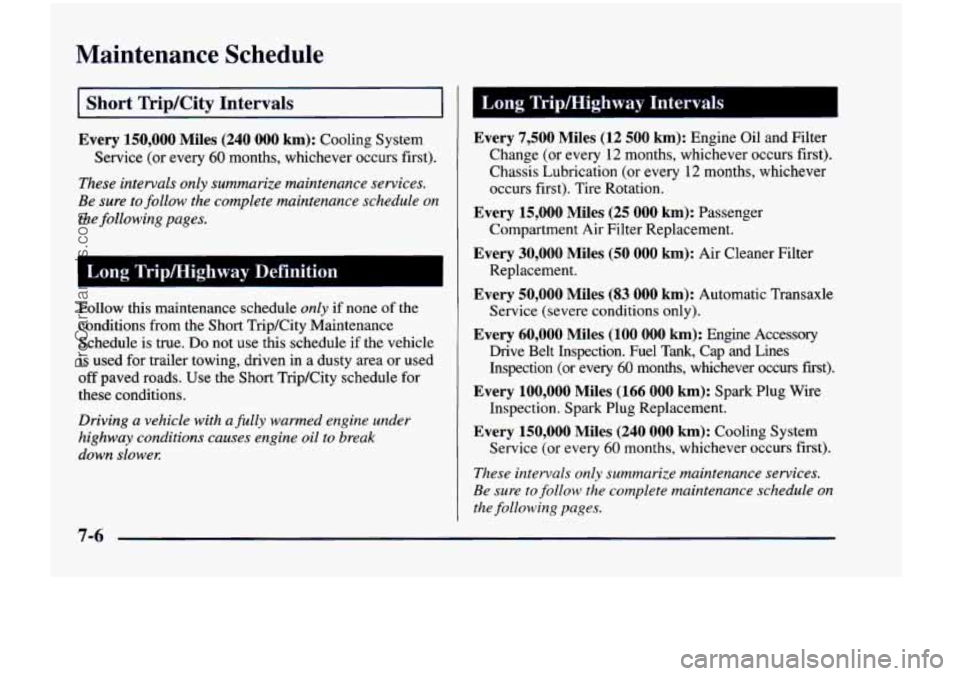
Maintenance Schedule
I Short TripKity Intervals
Every 150,000 Miles (240 000 km): Cooling System
Service (or every
60 months, whichever occurs first).
These intervals only summarize maintenance services.
Be sure to follow the complete maintenance schedule on
the following pages.
Follow this maintenance schedule only if none of the
conditions from the Short TripKity Maintenance
Schedule is true.
Do not use this schedule if the vehicle
is used for trailer towing, driven in
a dusty area or used
off paved roads. Use the Short TripKity schedule for
these conditions.
Driving a vehicle with afully warmed engine under
highway conditions causes engine oil
to break
down slower:
Long Tripmighway Intervals
Every 7,500 Miles (12 500 km): Engine Oil and Filter
Change (or every
12 months, whichever occurs first).
Chassis Lubrication (or every
12 months, whichever
occurs first). Tire Rotation,
Compartment Air Filter Replacement.
Replacement. Service (severe conditions only).
Drive Belt Inspection. Fuel Tank, Cap and Lines
Inspection (or every
60 months, whichever occurs first).
Every 100,000 Miles (166 000 km): Spark Plug Wire
Inspection. Spark Plug Replacement.
Every 150,000 Miles (240 000 km): Cooling System
Service (or every
60 months, whichever occurs first).
These intervals only summarize maintenance services.
Be sure
to follow the complete maintenance schedule on
the following pages.
Every 15,000 Miles (25 000 km): Passenger
Every 30,000 Miles (50 000 km): Air Cleaner Filter
Every 50,000 Miles (83 000 km): Automatic Transaxle
Every 60,000 Miles (100 000 km): Engine Accessory
ProCarManuals.com